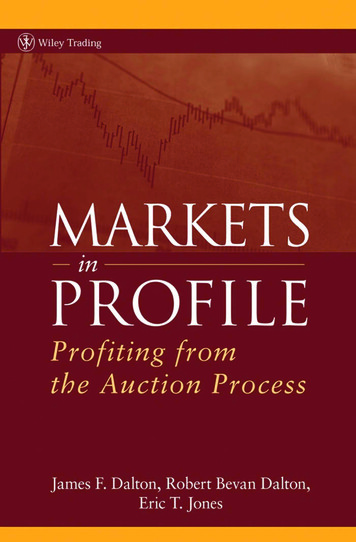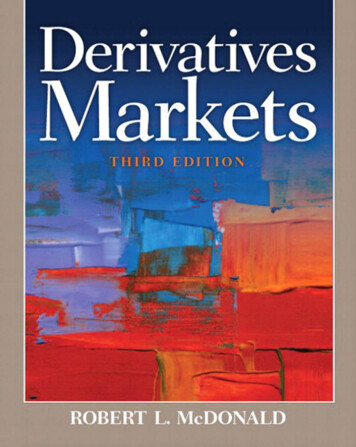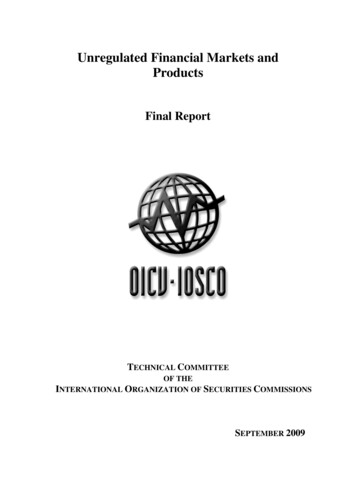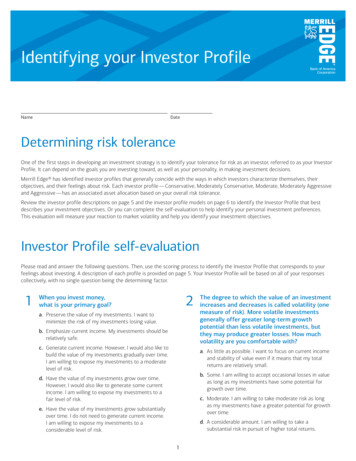
Transcription
JWDD030-FMJWBK129-Dalton metricsJanuary 13, 200718:29Char Count 0Markets inProfilei
JWDD030-FMJWBK129-Dalton metricsJanuary 13, 200718:29Char Count 0Founded in 1807, John Wiley & Sons is the oldest independent publishing company in the United States. With offices in North America, Europe,Australia, and Asia, Wiley is globally committed to developing and marketingprint and electronic products and services for our customers’ professionaland personal knowledge and understanding.The Wiley Trading series features books by traders who have survivedthe market’s ever changing temperament and have prospered—some byreinventing systems, others by getting back to basics. Whether a novicetrader, professional or somewhere in-between, these books will providethe advice and strategies needed to prosper today and well into the future.For a list of available titles, visit our Web site at www.WileyFinance.com.ii
JWDD030-FMJWBK129-Dalton metricsJanuary 13, 200718:29Char Count 0Markets inProfileProfiting from the AuctionProcessJAMES DALTONROBERT BEVAN DALTONERIC T. JONESiii
JWDD030-FMJWBK129-Dalton metricsJanuary 13, 200718:29Char Count 0C 2007 by James Dalton, Robert Bevan Dalton, and Eric Jones. All rights reserved.Copyright Published by John Wiley & Sons, Inc., Hoboken, New Jersey.Published simultaneously in Canada.No part of this publication may be reproduced, stored in a retrieval system, or transmitted in anyform or by any means, electronic, mechanical, photocopying, recording, scanning, or otherwise,except as permitted under Section 107 or 108 of the 1976 United States Copyright Act, withouteither the prior written permission of the Publisher, or authorization through payment of theappropriate per-copy fee to the Copyright Clearance Center, Inc., 222 Rosewood Drive, Danvers,MA 01923, (978) 750-8400, fax (978) 646-8600, or on the Web at www.copyright.com. Requests tothe Publisher for permission should be addressed to the Permissions Department, John Wiley& Sons, Inc., 111 River Street, Hoboken, NJ 07030, (201) 748-6011, fax (201) 748-6008, or onlineat http://www.wiley.com/go/permissions.Limit of Liability/Disclaimer of Warranty: While the publisher and author have used theirbest efforts in preparing this book, they make no representations or warranties with respectto the accuracy or completeness of the contents of this book and specifically disclaim anyimplied warranties of merchantability or fitness for a particular purpose. No warranty may becreated or extended by sales representatives or written sales materials. The advice and strategiescontained herein may not be suitable for your situation. You should consult with a professionalwhere appropriate. Neither the publisher nor author shall be liable for any loss of profit or anyother commercial damages, including but not limited to special, incidental, consequential, orother damages.For general information on our other products and services or for technical support, pleasecontact our Customer Care Department within the United States at (800) 762-2974, outside theUnited States at (317) 572-3993 or fax (317) 572-4002.Wiley also publishes its books in a variety of electronic formats. Some content that appearsin print may not be available in electronic books. For more information about Wiley products,visit our Web site at www.wiley.com.Library of Congress Cataloging-in-Publication Data:Dalton, James F.Markets in profile : profiting from the auction process / James Dalton,Robert B. Dalton, Eric T. Jones.p. cm.—(Wiley Trading Series)Includes bibliographical references and index.ISBN-13: 978-0-470-03909-0 (cloth)1. Investments. 2. Auctions. 3. Risk management. I. Dalton, Robert B.II. Jones, Eric T., 1961– III. Title.HG4521.D1197 2007332.64—dc222006030339Printed in the United States of America.10 9 8 7 6 5 4 3 2 1iv
JWDD030-FMJWBK129-Dalton metricsJanuary 13, 200718:29Char Count 0To all those intrepid traders who – from this day forward – willaccept both the financial and emotional risks inherent inmaking that final decision to buy or sell.v
JWDD030-FMJWBK129-Dalton metricsJanuary 13, 200718:29viChar Count 0
JWDD030-FMJWBK129-Dalton metricsJanuary 13, 200718:29Char Count 0ContentsPrefacexiAcknowledgmentsCHAPTER 1The Only Constantxix1The Creation of ERISA4The Rise and Fall of Relative Performance4The Fall of the Great Bull6The Rise of Absolute Return7Succeeding in an Absolute Return Market Environment8Pure, Unbaised Information10People Change Markets, Markets Change People13CHAPTER 215InformationFundamental Information16Rational or Irrational?18Market-Generated Information19The Auctions20Fair Value21Market Profile Fundamentals22Authors’ Note22Demystifying Market Behavior27CHAPTER 329TimeframesBreaking Down Market TimeframesScalperDay Trader313232vii
JWDD030-FMJWBK129-Dalton metricsJanuary 13, 200718:29Char Count 0viiiCONTENTSShort-Term TradersIntermediate Traders/InvestorsLong-Term Investors323335Your Timeframe Is your Strategy Cornerstone39CHAPTER 441Auctions and IndicatorsThe Search for ValueConcept Review4245Key Market-Generated Indicators48Perfecting the Art of Visualization56CHAPTER 559Long-Term AuctionsAuctions in Action60The Compound-Auction Process61The EBB and Flow of Balance62Where Do Trends End and Brackets Begin?64Clarity in the Maelstrom66The Big Picture68Asymmetric Opportunities and Risk72Long-Term Strategy Development74Assembling the Big Picture: Context within Context75CHAPTER 677Intermediate-Term AuctionsConvergence and the Bracketing Process77Defining the Intermediate Term79The Transition from Bracket to Trends80The Transition from Trend to Bracket82The Convergence of Intellect and Emotion85Accelerate the Learning Process86Prelude to a Sea Change87Hear the Bells A-Ringing94Countertrend Auctions94The Quest to Do Better than ‘‘Normal’’96Oh, the Difference a Few Points Makes97
JWDD030-FMJWBK129-Dalton metricsJanuary 13, 200718:29Char Count 0ixContentsCHAPTER 7Short-Term TradingAnalyzing Short-Term Markets99101Common Mind Traps104When and Where to Look for Short-Term Trades105Opportunities Around Intermediate-Term Brackets106Technical Indicators106Your Own Worst Enemy: Your Brain110Seeking the ‘‘Exceptionally Tasty Patterns’’112All Prices and Opportunities Are Not Equal116Ongoing Forensic Investigation121Looking for the All-Important Reference Points124Never Be a Laggard129A Golden Opportunity130Fade the Extremes, Go with Breakouts132‘‘The Expert Reasons Contextually’’137CHAPTER 8141Day Trading Is for EveryoneWhat’s a Day Trader to Do?142What You Don’t Do May Be More Important thanWhat You Do145The Real World in Action146Top Down152Lack of Conviction152Flight to Safety153Inventory Imbalances154Correction of Inventory Imbalances155Trend Traders’ Trap157Market Condition158Yesterday’s Trade162Example 1Example 2Example 3Trader Checklist162165167170
JWDD030-FMJWBK129-Dalton metricsJanuary 13, 200718:29Char Count 0xCONTENTSThe Market Is eOpen-AuctionDay Trader’s ChecklistExample 1Example 2Example 3171175178181181183185188Practice, Practice, PracticeCHAPTER 9171Profiting from Market-GeneratedInformation190193Timeframe Diversification194The New Paradigm196Appendix A: Market Update199About the Authors201Index203
JWDD030-FMJWBK129-Dalton metricsJanuary 13, 200718:29Char Count 0PrefaceYou can manage risk but not return.—Peter BernsteinThis book is about gaining an advantage over your competitors.To achieve this advantage, you must first discard the belief thatthere is a linear relationship between risk and reward. The primary objective of investing (and trading) is to identify asymmetric opportunities.Tocapitalize on these opportunities, you must learn to identify imbalancesthat reveal themselves in evolving market structure. But that is only thebeginning—you must also understand the way you process and respond toinformation, so your ability to act is not blocked or distorted by peripheralinfluences.Markets in Profile: Profiting from the Auction Process introduces aunified theory that explains the market’s auction process in relation to thehuman decision-making process, and the way market behavior affects human behavior. The bottom line? You are equipped to manage risk, whichputs you miles ahead of the pack.MARKETS ARE RATIONAL, PEOPLE ARE NOTThe “efficient markets” theory is half right. The market’s mechanism forallocating prices is extremely fair. It’s a simple two-way auction processby which price moves over time to facilitate trade either up or down—anextremely rational, efficient process.The other half of the efficient market equation, however, is often wrong;people are seldom rational when they make financial decisions. The first steptoward more profitable investing is to accept that market irrationality is dueto the fact that people make decisions based on (unavoidably) incompleteinformation, which often results in the worst decisions being made when itis most important to be right.Human nature is such that we tend to overweight information that supports our presupposed inclinations. We seek out a few pieces of the biggerxi
JWDD030-FMJWBK129-Dalton metricsJanuary 13, 2007xii18:29Char Count 0PREFACEpicture that make us feel confident in our decisions. This recurring overconfidence is behind the idea that markets are “irrational in a predictablemanner,” a landmark theory put forth by Nobel Prize–winning psychologistsDaniel Kahneman and Amos Tversky.But Kahneman and Tversky didn’t take this information to the nextlevel. They didn’t explore how to take advantage of that fact. In this book,we show you how the auction process both records and reveals marketstructure—and how, within that structure, predictability manifests itself inrecognizable forms such as the “excess” that occurs at the end of an auction.We show you how excess is formed, too, and how to view it objectively inorder to better manage risk.All markets alternate between periods of stability and crisis. By monitoring market structure in real-time context, it is possible to recognizeparadigm shifts in equilibrium. Market indicators such as excess make itpossible to identify when the status quo is changing, which results in opportunities to distinguish favorable (and unfavorable) investment opportunities. In other words, it is possible to ameliorate risk by recognizingimbalances caused by irrational human behavior such as the herd instinct,which pushes price away from value.Everyone talks about the problems of investing and market behavior. Weare proposing a solution, a means of interpreting market behavior throughthe lens of human consciousness, and then quantifying that information ina way that enables investing on a more probabilistic basis.IS THIS BOOK FOR YOU?Authors’ NoteWhile this is a collaborative work, the rest of the preface and many of theexperiences shared throughout the book are written from the perspectiveof lead author Jim Dalton, who has spent his career furthering his understanding and mastery of the markets.As the lead author, I’m often asked if I’m writing for investors or traders.I believe such distinctions are in many ways arbitrary for there is no linewhere one stops and the other ends. It’s a spectrum, and every individualand every institution falls on a different point. That point changes constantlydepending on the phase of activity. Even the longest-term investor shouldchange his decision-making process in order to exit or enter a position. Trim,add, raise cash, change asset allocation—these are all timing decisions.In The Tipping Point, Malcolm Gladwell could have been writing aboutmarkets when he described crime as not “a single discrete thing, but a
JWDD030-FMJWBK129-Dalton metricsJanuary 13, 200718:29Char Count 0Prefacexiiiword used to describe an almost impossibly varied and complicated set ofbehaviors.”Perhaps you’re a growth investor. Or a value investor. Large cap, smallcap—most institutional investors tend to pick a style and stick with it. Thetheories in this book are not dependant on the condition of the market, noron what style is currently in favor. In fact, much of the power and appeal ofthese theories is that they are totally agnostic in terms of style, cap size, andasset class. The concepts you encounter are equally applicable to any styleof investing, any timeframe, even any market, because the auction processworks equally well for futures, real estate, art, even eBay.The core idea is simple: all financial markets are measurable by time,price, and volume. This multidimensional approach to interpreting marketgenerated information enables you to differentiate between prices, becauseall prices are not equal. By extension, all opportunities are not equal, whichis key in managing the probabilities of risk.THERE IS NO CERTAINTY—THERE AREONLY PROBABILITIESMarkets react to countless influences other than fundamental companynews. There are natural disasters, terrorist attacks, wars, and political imbroglios that cause markets to become too long or too short in different timeframes. It is often the shorter-term uncertainties that can make or break amoney manager, putting sizable divots in the results investors use to choosefund allocation. One bad quarter can sink a portfolio and mar a stellar fiveyear track record.Modern portfolio theory depends heavily upon diversification by assetclass, sectors, individual securities, and so on. One of the core tenets of thisbook is that such diversification is not enough—you must also diversifyby timeframe. Timeframe diversification is a staple for fixed income managers, who frequently diversify by owning short-, intermediate-, and longterm instruments. This approach should be natural for equity investors andinvestment advisors as well.Successful timeframe diversification can help hedge against the major liquidating breaks, short-covering rallies, and other short-term marketmovements caused by news events that can push markets to the breakingpoint. What I’m getting at is that managers often throw in the towel at exactlythe wrong time. This is undoubtedly why there’s a saying that markets willtrade to levels that cause the most pain for the greatest number of investors.Change is the great common denominator. When change occurs, weare most vulnerable, and the natural human tendency is to grasp for what is
JWDD030-FMJWBK129-Dalton metricsJanuary 13, 200718:29Char Count 0xivPREFACEfamiliar, what has “worked” before. That’s why it is so important to learn toidentify the basic structure of change through conscious attention to evolving market conditions. Recognizing the patterns that precipitate change canmake the difference of a couple hundred basis points. And that, in a highlycompetitive world, can be the difference between feast and famine.An investor or investment advisor who understands that markets donot change in a linear fashion, and that risk and return must be managedby interpreting change as it occurs in the present tense, is better able torecognize and capitalize on risk asymmetries. Ultimately, that is what distinguishes the successful investor from both the long-only and absoluteschools of thought.KNOW THE MARKET, KNOW YOURSELF,MANAGE RISKThe world wants absolute answers. This is why we are being careful to notethat what we are suggesting is not an academic model to replace the efficientmarket hypothesis. The conundrum is that mathematics and factor-modelapproaches are more consistent than human intuition, but they don’t allow for enough flexibility to respond to rapidly changing market situations.They don’t allow you to distance yourself from competitors who apply similar models. It’s like watching the world championship of poker—all thegood players know the odds. That’s why winning takes another level ofunderstanding.This book separates the market mechanism from the investor. While itis possible to describe the workings of any market within a single coherentframework, that knowledge represents only half of the equation. It is notenough to grasp how markets work; you must also understand how youtake in and process information, and then execute based on that information. This concept has gained currency since “Prospect Theory” establishedthat we are not rational decision makers. Our emotions can weaken or completely eliminate our self-control . . . but we’ll save a thorough discussion ofhuman behavior and neuroeconomics for a later chapter.We’re simply suggesting that traditional fundamental analysis can beenhanced with real-time context—time, price, and volume. By interpretinganalysis in relation to market-generated information, the investor can better understand the nature of change, which can positively influence tradelocation. Trade location is the key to controlling risk and taking advantageof asymmetric opportunities that occur within developing market structure.In recent years, the bifurcation of the brain has been explored thoroughly in popular media. We are not the first to suggest that successful
JWDD030-FMJWBK129-Dalton metricsJanuary 13, 2007Preface18:29Char Count 0xvinvesting (or successful anything) incorporates both sides of the brain. Thegoal is to balance the analytical hemisphere, made manifest in vital fundamental research, with the pattern recognition of the intuitive hemisphere ina present-tense process.We’re talking about whole-brained investing—a holistic, context-basedunderstanding of market activity. As in all things, balance is the key tosuccess, a concept that will appear throughout this book.SO WHY LISTEN TO ME?I’ve spent my entire career in and around the markets. That experience hasresulted in two fundamental beliefs: First, that intelligence and understanding do not necessarily go hand-in-hand, and second, that patience and selfcontrol can be illusory.I entered the industry nearly 40 years ago as a broker for a major WallStreet firm armed with a strong sales record and the belief that my successdepended only on selling the stocks that my research recommended. I wasa good salesman, but I was naı̈ve and inexperienced. I didn’t know it at thetime, but it would take many years of learning and hard work before I couldconfidently say that I was consistently making money for myself, my firm,and my clients. I have tried to forget the financial pain I inflicted duringthose early years (as well as the psychological pain I endured from failingto meet my own expectations). Some of that cognitive dissonance resultedfrom poor stock selection, but some was from a lack of experience thatkept me from cautioning customers against their own ideas.When I first became a broker, the importance of raising capital was impressed upon me. The job was vital, I was told, because capital “nourishesour country.” I quickly learned that no one really cares about the capitalraising function unless they own the company. Clients? They just wanted topurchase winners and get rich. This realization shaped the central motivation of my professional career: to independently seek profitable situationsfor my clients.It was made very clear to me at the time, however, that I was expected tofollow the firm’s research. After all, the research department was comprisedof the brightest minds on Wall Street. During my initial broker-training program, an economist who is still widely recognized told us that he wasn’tinterested in buying any stocks that were then available. When I returnedto California after training, that economist was no longer employed by thefirm. Soon after, a widely respected analyst suggested that there were veryfew buy candidates among the stocks that she followed. She was allowedto keep her position, but was reportedly placed on probation. Around the
JWDD030-FMJWBK129-Dalton metricsxviJanuary 13, 200718:29Char Count 0PREFACEsame time, which was just prior to the Bear Market of the early 1970s,I bought some energy and gold stocks, which were profitable for clients,only to have my commissions rescinded because the stocks I bought werenot on the firm’s “recommended list.”I began to observe surprising behavior in some of the stocks that werepurchased from the recommended list. They declined significantly following higher than expected earnings. I became enamored with the slogan “buythe rumor, sell the news.” The problem was that it didn’t always work. Overtime I observed that although the analysis of a company was often correct,the market’s ensuing movement wasn’t always consistent with that analysis. This is where I learned that fundamental analysis enables only a partialunderstanding of the bigger picture.I changed firms with a big check in hand, as well as the assurance thatthe next firm’s research was superior to that of the prior firm, and that myworld would turn around. This was during the Bear Market of the 1970s andthe market was on its way down to 500 from 1,000. Nothing worked. Rightnear the bottom, I learned how to short stocks and was successful with myfirst two shorts. The next short was Fannie Mae, which only required 25percent margin. Do I need to continue?One of the pivotal experiences in my life began there, at the bottom ofthe market: I became interested in buying and writing options. In those days,the options business was conducted through a series of independent put andcall dealers who matched buyers and sellers in nonfungible transactions.During this same period, I had another introduction to the early derivativesmarkets when Edward O. Thorp, the legendary card counter, trader, andcoauthor of Beat the Dealer and Beat the Market: A Scientific Stock MarketSystem, opened an account with me. What his firm would do was buy stocksand sell warrants against those stocks, knowing that they would convergeat expiration. My recollection is that their returns were in the 20 percentrange.In the early 1970s, my experience with options and warrants broughtme a job offer from Joe Sullivan, who was the first president of thefledgling Chicago Board Options Exchange (CBOE). I gave up my memberships on both the Chicago Board of Trade (CBOT) and the CBOE tojoin Joe. As an executive vice president of the CBOE during its formative years, I was exposed to the various segments of the securities industry as well as the hordes of academics who were then conducting research and engaging in financial engineering involving options and otherderivatives. During this period, I observed that a lot of firms and individualtraders that employed single strategies—strategies that were highly successful for a while—saw those same strategies implode during economiccrises caused by system abuse and overextension. I began to understandthat no single strategy can work (for long) for all markets; those with
JWDD030-FMJWBK129-Dalton metricsPrefaceJanuary 13, 200718:29Char Count 0xviisuperior results over the longer term were flexible, adaptive to changingconditions.I observed how often, at major tops and bottoms, the experts and institutional investors seemed to share similar beliefs—beliefs that were simplywrong. I realized that long-term forecasting is unreliable because unforeseen events are bound to occur. I came to the conclusion, during these periods, that being skeptical, value oriented, and independent were far moreimportant than being with the majority, especially at the extremes.Even though I began to better understand what it takes to be successful, I was still never comfortable moving against the crowd. We are socialanimals after all, longing to belong. We all want to be part of a larger family,and every decision we make is in some way influenced by that desire.In the late 1980s, I was introduced to a new theory, a method of arrangingdata that allowed me to see how markets are organized. I met Peter Steidlmayer, who is credited with developing Market Profile for the ChicagoBoard of Trade (CBOT ), a graphical organization of price and time information that displays price on the vertical axis and time on the horizontalaxis—the decision support tool for traders used in this book. Peter askedme if I wanted to sponsor the book that he and Kevin Koy were writing. Iimmediately recognized the value of this new concept and delivered a checkfor 10,000 to sponsor Markets and Market Logic (Philadelphia: PorcupinePress, 1986). My son Rob Dalton, Eric Jones, and I then expanded and elaborated on Pete’s work in Mind Over Markets (New York: McGraw-Hill, 1990),which provides a wealth of tactical trading information. I’m happy to reportthat in 2005 Mind Over Markets has been published in a Chinese edition.After spending several years trading on my own and mentoring othertraders, UBS (Union Bank of Switzerland) Financial Services asked me ifwould return for a fourth time and reorganize their nonproprietary hedgefund business. This resulted in another significant pivot point in my career—as manager of Hedge Fund Research, I was in direct contact with manypremier hedge funds and successful traders.Having established an efficient process for reviewing hedge funds, myfirm then offered me the position of director of research for managed accounts, a position that I was responsible for until I retired in August 2005. Inthis role, I was exposed not only to hedge funds but also to more traditionalfirms, some of which had upward of a trillion dollars under management.I was surprised to discover how poor the actual results were for manyof these relative-return firms, especially on a long-term basis. While somemay have had decent relative returns (within their peer group), the absolute returns were often disappointing. I feel safe in suggesting that mosthedge fund and relative-return managers could significantly benefit fromthe concepts in this book.
JWDD030-FMJWBK129-Dalton metricsxviiiJanuary 13, 200718:29Char Count 0PREFACEA long time ago, at the beginning of my career, I became the number-onesalesman at IBM by meeting with clients, upsetting their homeostasis andthen giving them a solution to resolve their state of unease. That model isstill working for me today. Markets in Profile offers a new, holistic theoryfor market understanding.For the inquisitive spirit, I believe this book provides the basis for profound insight into a more coherent form of risk management. (And it’s a funread.)
JWDD030-FMJWBK129-Dalton metricsJanuary 13, 200718:29Char Count 0AcknowledgmentsWe have singled out a few individuals and organizations for havingprovided definitive insight or support; Markets in Profile was bornout of years of teaching, research, and trading.J. Peter Steidlmayer pioneered the original theories that served as ourcontinual point of embarkation for both Markets in Profile and our earlierbook, Mind Over Markets.Brett N. Steenbarger was introduced to us after he read Mind Over Markets from the world of “protected academic medicine,” as he put it (Brettwas assistant professor of psychiatry and assistant dean of the College ofMedicine, SUNY Health Science Center at Syracuse). Brett wrote us a twopart response to the book, spanning more than 60 pages, that was heavilyfocused on the, you have a healthy understanding of both markets and yourself. Brett connected the structure of the market profile with the ways inwhich our brains efficiently collect and visualize information. He also introduced us to formative theories on how change occurs in both individualsand organizations. This well-reasoned response triggered several years ofreading and research that led to a deeper understanding of cognition, behavioral finance, and neuroeconomics (you will notice that there are far morereferences to books relating to these subjects than there are to books thatexplicate market mechanics in Markets in Profile). One of the fundamental keys to successful trading, we believe, is understanding how marketschange people, and how people change markets.CQG, for their quality ongoing technical support over the years. CQGis responsible for many of the charts and data presented in this book.WINdoTRADEr, a software utility that allows for the flexible implementation of Market Profile graphics and provides features for performingvolume analysis. We have worked closely with WINdoTRADEr, consistentlyoffering suggestions for improving this helpful, fully customizable utility.Each of the three authors has contributed to Markets in Profile in aunique way. Stylistically, the book was written from the perspective ofJames Dalton, who has dedicated decades to an active, intense involvementxix
JWDD030-FMJWBK129-Dalton metricsxxJanuary 13, 200718:29Char Count 0ACKNOWLEDGMENTSwith the day-to-day markets. Rob Dalton is a professional writer (and occasional poet) with an exceptional ability to translate complex ideas intoa clear, compelling dialogue. Eric Jones, Jim’s original trading partner, hasresearched, studied, and written about the markets and foreign exchangefor many years. Having spent the past several years as a senior officer withone of the world’s largest financial services firms, Eric contributed a wealthof experience with the Market Profile, and provided guidance in developingconcepts that would resonate with other senior officers of financial servicesfirms.CBOT Market Profile and Market Profile are registered trademarksof the Chicago Board of Trade (CBOT), which holds exclusive copyrights toboth. The views expressed in this publication are exclusively those of theauthors.
chapter01JWBK129-Dalton metricsJanuary 4, 200721:21Char Count 0CHAPTER 1The OnlyConstantIt is not necessary to change. Survival is notmandatory.—W. Edwards DemingMy first car was a used ’49 Chevy. We could pull it into the garageand change the plugs, set the timing, clean the carburetor and beon our way. Back then, it was relatively easy to understand enginesand how to keep them running smoothly. Today, if someone asked me toexplain the first thing about what’s happening under the hood of my car, Iwouldn’t have a clue.There’s a parallel between that Chevy and my first excursi
CHAPTER 7 Short-Term Trading 99 Analyzing Short-Term Markets 101 Common Mind Traps 104 When and Where to Look for Short-Term Trades 105 Opportunities Around Intermediate-Term Brackets 106 Technical Indicators 106 Your Own Worst Enemy: Your Brain 110 Seeking the ''Exceptionally Tasty Patterns'' 112 All Prices and Opportunities Are Not .










